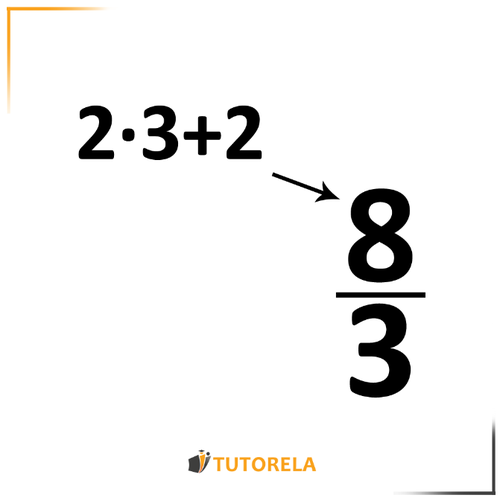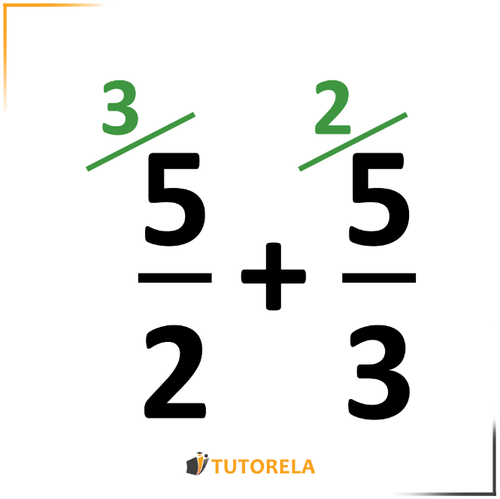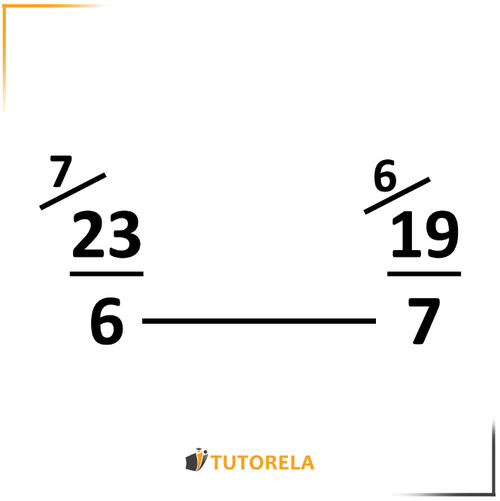The integer is multiplied by the denominator. The obtained product is then added to the numerator. The final result is placed as the new numerator.
Nothing is changed in the denominator.
A fraction greater than is a fraction whose numerator is larger than the denominator.
Mixed Numbers and Fractions Greater Than 1
How do you convert a mixed number to a fraction?
Test yourself on mixed numbers and fractions greater than 1!
Write the fraction as a mixed number:
\( \frac{6}{2}= \)
Fraction greater than one
In this article, we will learn everything necessary about mixed numbers and fractions greater than .
We will learn how to convert everything to a fraction, subtract, add, multiply, and compare. All in an easy and efficient way.
What is a mixed number?
A mixed number is a number made up of a whole number and a fraction - hence its name - it combines whole numbers and fractions.
Examples of mixed numbers:
, ,
Write the fraction shown in the drawing:
Write the fraction shown in the drawing:
Write the fraction shown in the drawing:
How do you convert a mixed number to a fraction?
Let's see it by practicing
Let's look at this mixed number
To find the numerator we multiply the whole number by the denominator. To the product obtained we add the numerator.
Nothing is modified in the denominator.
We will obtain:

What does a fraction that is greater than 1 look like?
First, let's see what a fraction equivalent to looks like.
A fraction equivalent to is one whose numerator and denominator are equal. For example, or .
A fraction greater than is a fraction whose numerator is larger than the denominator.
Whenever the numerator is larger than the denominator, the fraction will be greater than . For example,
Observe:
Every mixed number is greater than and we can write it in the form of a fraction that is greater than .
Practice:
Convert the mixed number to a fraction greater than .
Solution:
We will multiply the whole number by the denominator and add the numerator to the product. We will write the result in the numerator
The denominator will not be altered.
We obtain:
It is clear that the fraction obtained is greater than –> the numerator is larger than the denominator.
Write the fraction shown in the drawing:
Write the fraction shown in the drawing:
Write the fraction as a mixed number:
\( \frac{13}{11}= \)
How do you convert a fraction greater than 1 into a mixed number?
In certain cases, when we want to find out the number of units or just to order the final result, we prefer to convert a fraction greater than to a mixed number.
We will do it in the following way:
We will calculate how many whole times the numerator fits into the denominator - this will be the whole number.
What remains, we will write in the numerator, and the denominator will remain unchanged (does not change).
Let's learn by practicing:
Here is a fraction greater than :
To convert it to a mixed number we will divide the numerator by the denominator. Let's ask ourselves how many whole times fits into ?
We will obtain:
3 times -> this will be the whole number of the result.
Now let's see what remains to complete the numerator .
What is the remainder?
We have a remainder of , that is what is placed in the numerator.
The final result is:
Addition and Subtraction
When we talk about addition and subtraction of fractions, the first step is to convert everything to fractions (without whole numbers).
This way we can reach the common denominator and then add or subtract the numerators.
Write the fraction as a mixed number:
\( \frac{8}{5}= \)
Write the fraction as a mixed number:
\( \frac{12}{10}= \)
Write the fraction as a mixed number:
\( \frac{13}{9}= \)
For example
Solution:
Given this addition exercise with a fraction larger than and a mixed number.
The first step is to convert the mixed number to a fraction in the way we have learned before.
It will give us:
Let's rewrite the exercise:

Now we will find the common denominator by multiplying the denominators and we will get:
We can convert the result to a mixed number like this:
Multiplication and Division
When we talk about multiplication and division, indeed, there is no need to find the common denominator, but it is necessary to convert mixed numbers into fractions.
This way, the operations will be carried out easily.
Comparison between a mixed number and a fraction greater than
To be able to compare a mixed number and a fraction greater than ,
The first thing we must do is, clearly, convert the mixed number to a fraction -> that is, a fraction with numerator and denominator.
Then, find the common denominator, only after this can we compare the numerators.
Let's practice:
Mark the corresponding sign
_______________
Solution:
We will convert the mixed number to a fraction and rewrite the exercise.
We will obtain:

We will find the common denominator by multiplying the denominators and we will obtain:
_______>________
Examples and exercises with solutions of mixed number and fraction greater than 1
Exercise #1
Write the fraction as a mixed number:
Video Solution
Step-by-Step Solution
To convert the improper fraction into a mixed number, we need to divide the numerator by the denominator:
Step 1: Evaluate the division .
By performing this division, we find that .
Since the division results in a whole number, the mixed number equivalent of is simply . Therefore, there is no fractional part remaining.
Thus, the fraction expressed as a mixed number is .
Answer
Exercise #2
Write the fraction shown in the drawing:
Video Solution
Step-by-Step Solution
The problem involves finding the fraction represented by shaded parts in a drawing. Here's a step-by-step guide to solve it:
- Step 1: Count the total number of sections in the drawing. There are 7 blocks arranged linearly.
- Step 2: Since each block appears to be fully shaded, count those shaded. Each of the 7 blocks is shaded.
- Step 3: The fraction is formed by placing the number of shaded sections over the total sections. Thus, the fraction is .
The fraction for the shaded portion of the drawing is , which is a complete whole, as every block is shaded.
Therefore, the solution to the problem is .
Answer
Exercise #3
Write the fraction shown in the drawing:
Video Solution
Step-by-Step Solution
To find the fraction represented by the shaded areas, follow these steps:
- Step 1: Count the total number of rectangles. There are 7 rectangles in the drawing.
- Step 2: Count the number of shaded rectangles. There are 3 shaded rectangles.
- Step 3: Form the fraction, using the number of shaded rectangles as the numerator and the total number of rectangles as the denominator.
Therefore, the fraction of the drawing that is shaded is .
This value corresponds to option 4 in the provided choices, confirming is the correct answer.
Answer
Exercise #4
Write the fraction shown in the drawing:
Video Solution
Step-by-Step Solution
To determine the fraction illustrated in the drawing, we must follow these procedures:
- Step 1: Count the Total Number of Parts
Examine the drawing to determine how many equal parts the entire shape is divided into. According to the drawing, the shape is divided into a total of 6 parts. - Step 2: Count the Shaded Parts
Next, count the number of parts that are shaded. From the drawing, we can identify that 3 of these parts are shaded. - Step 3: Write the Fraction
The fraction is represented by placing the number of shaded parts as the numerator and the total number of parts as the denominator. Therefore, we write the fraction as .
Thus, the solution to the problem is .
Answer
Exercise #5
Write the fraction shown in the drawing:
Video Solution
Step-by-Step Solution
To solve the problem, we will follow these steps:
- Step 1: Count the total number of equal parts shown in the drawing.
- Step 2: Count the number of shaded parts in the drawing.
- Step 3: Form the fraction using the number of shaded parts over the total number of parts.
Now, let's address these steps in detail:
Step 1: Count the total equal parts.
From the drawing, it appears there are 7 equal parts.
Step 2: Count the shaded parts.
There are 5 shaded parts highlighted in the drawing.
Step 3: Write the fraction.
Now, we write the fraction as:
This fraction represents the shaded area of the total, therefore the solution to the problem is .
Answer
Write the fraction as a mixed number:
\( \frac{7}{4}= \)
Write the fraction as a mixed number:
\( \frac{10}{7}= \)
Write the fraction as a mixed number:
\( \frac{10}{6}= \)
More Questions
Mixed Numbers and Fractions Greater than 1
- Visual Representation of the Fraction 3/4: Choose the Correct Diagram
- Visual Representation of the Fraction 8/40: Match the Correct Diagram
- Visual Representation of the Fraction 9/6: Choose the Correct Model
- Visual Representation of the Fraction 25/15: Choose the Correct Diagram
- Visual Representation of Improper Fraction 27/12: Choose the Correct Image
- The Order of Basic Operations: Addition, Subtraction, and Multiplication
- Order of Operations: Exponents
- Order of Operations: Roots
- Division and Fraction Bars (Vinculum)
- The Numbers 0 and 1 in Operations
- Neutral Element (Identity Element)
- Order of Operations with Parentheses
- Order or Hierarchy of Operations with Fractions
- Opposite numbers
- Elimination of Parentheses in Real Numbers
- Addition and Subtraction of Real Numbers
- Multiplication and Division of Real Numbers
- Multiplicative Inverse
- Integer powering
- Positive and negative numbers and zero
- Real line or Numerical line
- Addition and Subtraction of Mixed Numbers
- Multiplication of Integers by a Fraction and a Mixed Number
- Order of Operations - Exponents and Roots
- Special cases (0 and 1, reciprocals, fraction line)









